AUX TOYOTA TUNDRA HYBRID 2023 Owners Manual
[x] Cancel search | Manufacturer: TOYOTA, Model Year: 2023, Model line: TUNDRA HYBRID, Model: TOYOTA TUNDRA HYBRID 2023Pages: 618, PDF Size: 13.67 MB
Page 179 of 618
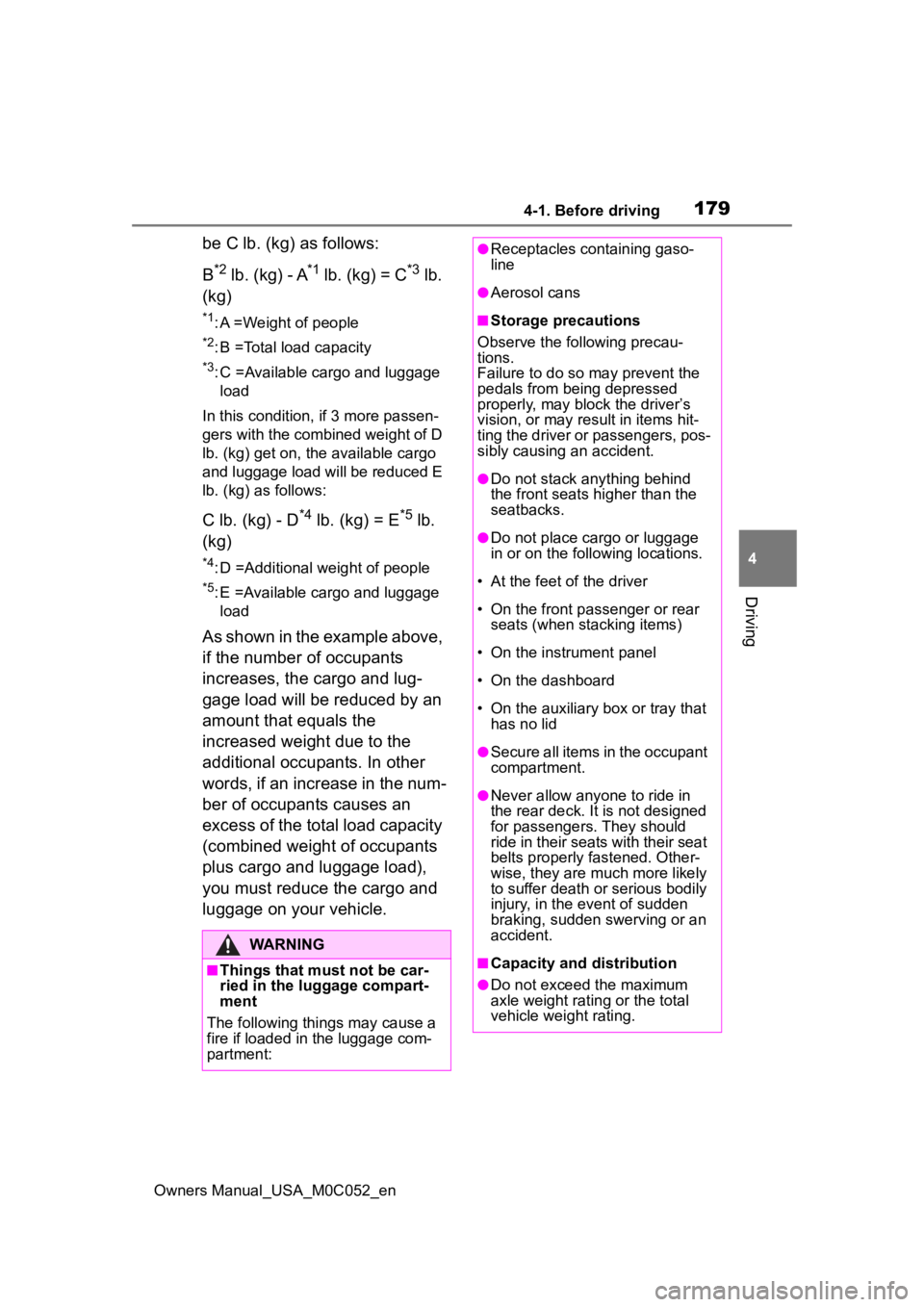
1794-1. Before driving
Owners Manual_USA_M0C052_en
4
Driving
be C lb. (kg) as follows:
B
*2 lb. (kg) - A*1 lb. (kg) = C*3 lb.
(kg)
*1: A =Weight of people
*2: B =Total load capacity
*3: C =Available cargo and luggage load
In this condition, if 3 more passen-
gers with the combined weight of D
lb. (kg) get on, the available cargo
and luggage load will be reduced E
lb. (kg) as follows:
C lb. (kg) - D*4 lb. (kg) = E*5 lb.
(kg)
*4: D =Additional weight of people
*5: E =Available cargo and luggage load
As shown in the example above,
if the number of occupants
increases, the cargo and lug-
gage load will be reduced by an
amount that equals the
increased weight due to the
additional occupants. In other
words, if an increase in the num-
ber of occupants causes an
excess of the total load capacity
(combined weight of occupants
plus cargo and luggage load),
you must reduce the cargo and
luggage on your vehicle.
WARNING
■Things that must not be car-
ried in the luggage compart-
ment
The following things may cause a
fire if loaded in the luggage com-
partment:
●Receptacles containing gaso-
line
●Aerosol cans
■Storage precautions
Observe the following precau-
tions.
Failure to do so may prevent the
pedals from being depressed
properly, may block the driver’s
vision, or may res ult in items hit-
ting the driver or passengers, pos-
sibly causing an accident.
●Do not stack anything behind
the front seats higher than the
seatbacks.
●Do not place cargo or luggage
in or on the follo wing locations.
• At the feet of the driver
• On the front passenger or rear seats (when stacking items)
• On the instrument panel
• On the dashboard
• On the auxiliary b ox or tray that
has no lid
●Secure all items in the occupant
compartment.
●Never allow anyon e to ride in
the rear deck. It is not designed
for passengers. They should
ride in their seats with their seat
belts properly fastened. Other-
wise, they are much more likely
to suffer death or serious bodily
injury, in the event of sudden
braking, sudden swerving or an
accident.
■Capacity and distribution
●Do not exceed the maximum
axle weight rating or the total
vehicle weight rating.
Page 411 of 618
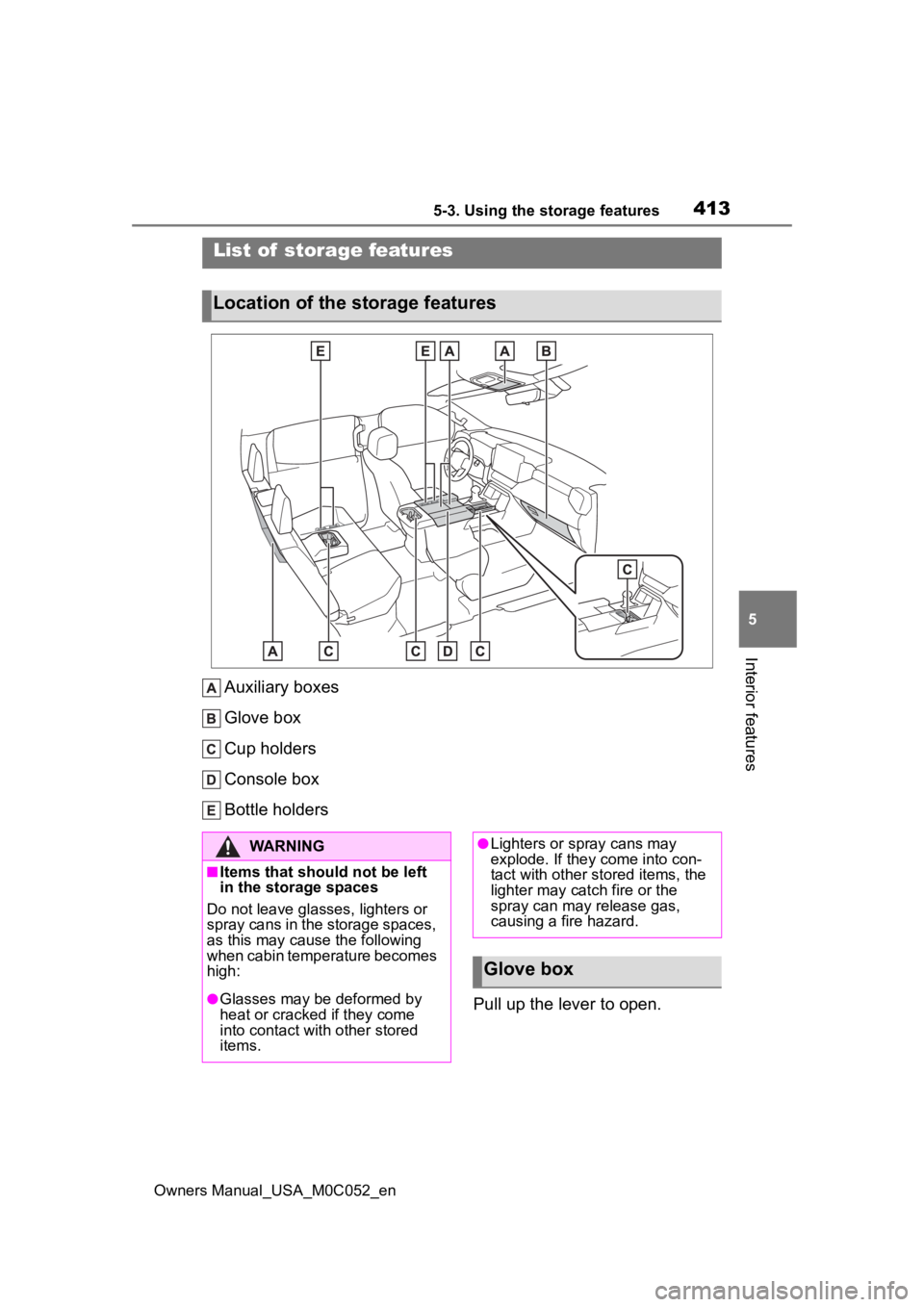
4135-3. Using the storage features
Owners Manual_USA_M0C052_en
5
Interior features
5-3.Using the storage features
Auxiliary boxes
Glove box
Cup holders
Console box
Bottle holders Pull up the lever to open.
List of storage features
Location of the storage features
WARNING
■Items that should not be left
in the storage spaces
Do not leave glasses, lighters or
spray cans in the storage spaces,
as this may cau se the following
when cabin temperature becomes
high:
●Glasses may be deformed by
heat or cracked if they come
into contact with other stored
items.
●Lighters or spray cans may
explode. If they come into con-
tact with other stored items, the
lighter may catch fire or the
spray can may release gas,
causing a fire hazard.
Glove box
Page 414 of 618
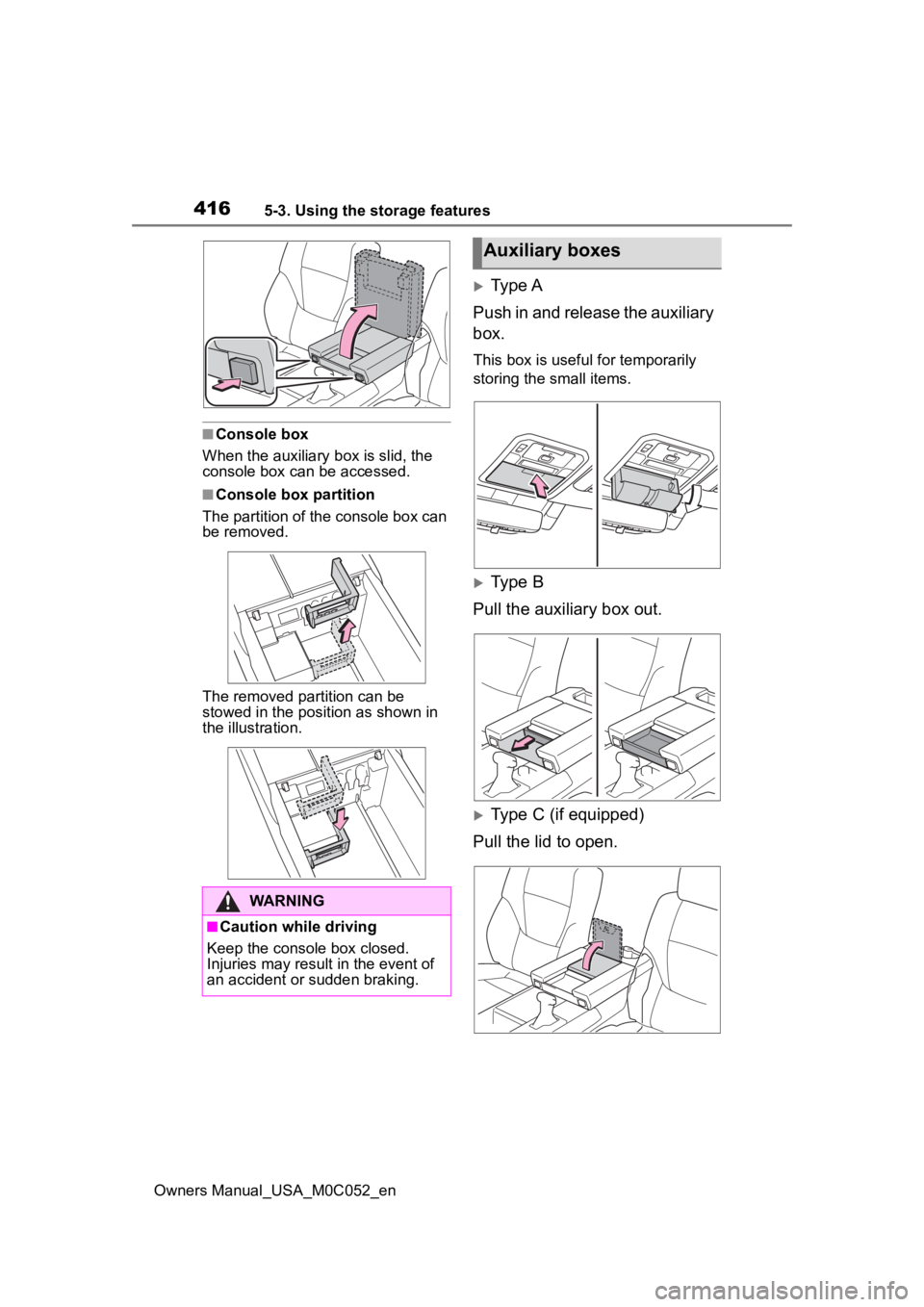
4165-3. Using the storage features
Owners Manual_USA_M0C052_en
■Console box
When the auxiliary b ox is slid, the
console box can be accessed.
■Console box partition
The partition of the console box can
be removed.
The removed partition can be
stowed in the posit ion as shown in
the illustration.
Type A
Push in and release the auxiliary
box.
This box is useful for temporarily
storing the small items.
Type B
Pull the auxiliary box out.
Type C (if equipped)
Pull the lid to open.
WARNING
■Caution while driving
Keep the console box closed.
Injuries may result in the event of
an accident or sudden braking.
Auxiliary boxes
Page 415 of 618
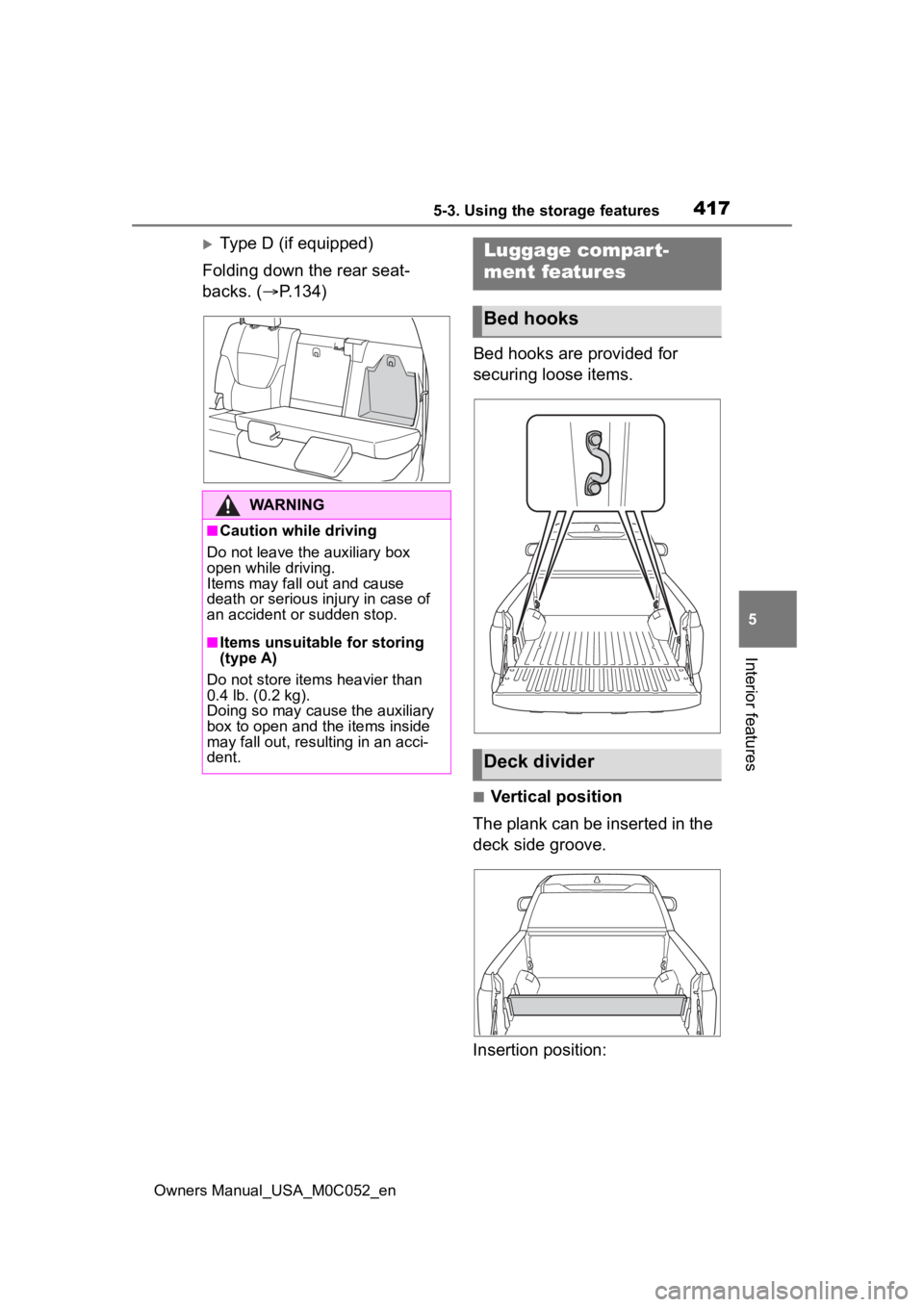
4175-3. Using the storage features
Owners Manual_USA_M0C052_en
5
Interior features
Type D (if equipped)
Folding down the rear seat-
backs. ( P.134)
Bed hooks are provided for
securing loose items.
■Vertical position
The plank can be inserted in the
deck side groove.
Insertion position:
WARNING
■Caution while driving
Do not leave the auxiliary box
open while driving.
Items may fall out and cause
death or serious injury in case of
an accident or sudden stop.
■Items unsuitable for storing
(type A)
Do not store items heavier than
0.4 lb. (0.2 kg).
Doing so may cause the auxiliary
box to open and the items inside
may fall out, resulting in an acci-
dent.
Luggage compar t-
ment features
Bed hooks
Deck divider
Page 454 of 618
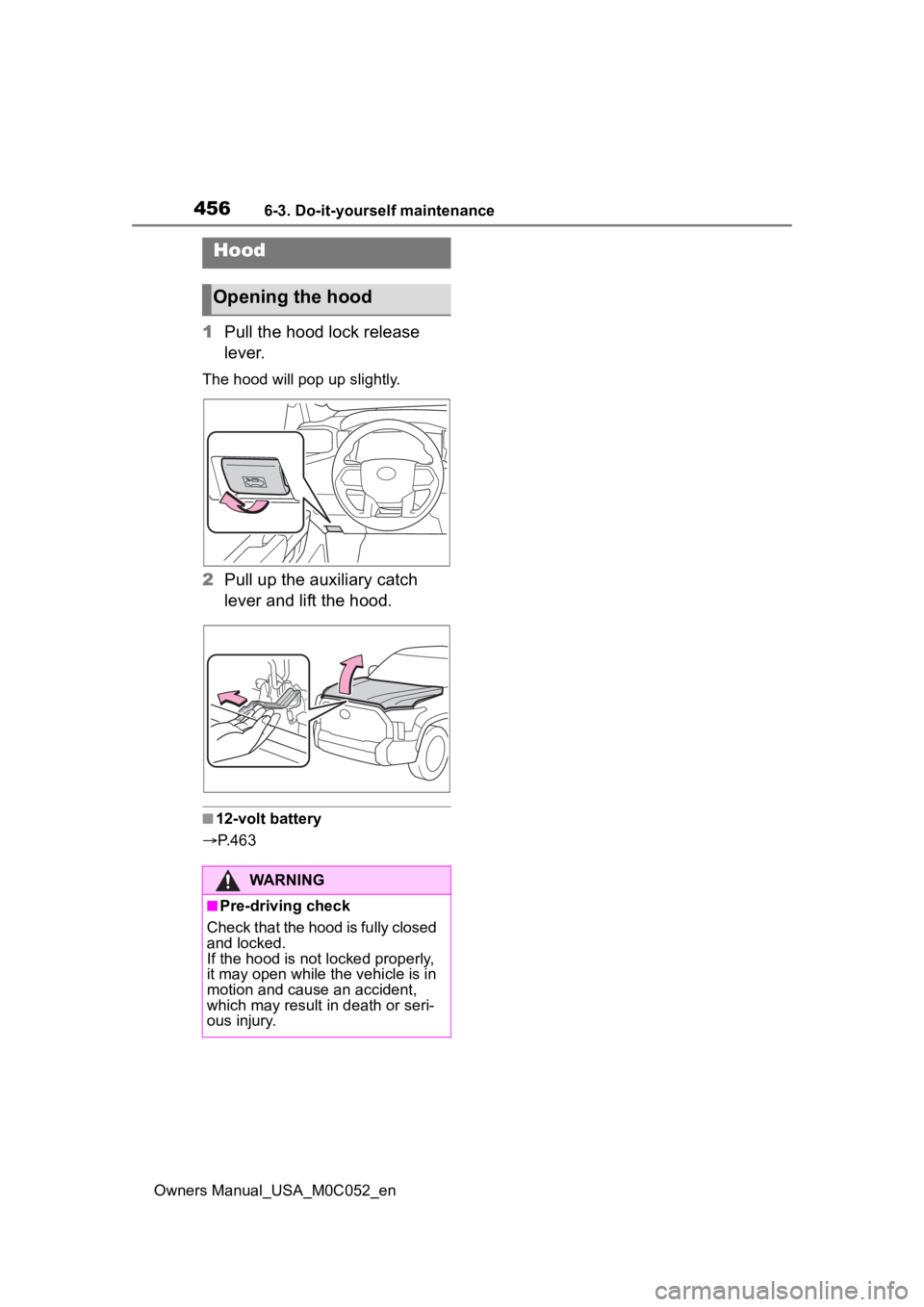
4566-3. Do-it-yourself maintenance
Owners Manual_USA_M0C052_en
1Pull the hood lock release
lever.
The hood will pop up slightly.
2Pull up the auxiliary catch
lever and lift the hood.
■12-volt battery
P. 4 6 3
Hood
Opening the hood
WARNING
■Pre-driving check
Check that the hood is fully closed
and locked.
If the hood is not locked properly,
it may open while the vehicle is in
motion and cause an accident,
which may result in death or seri-
ous injury.
Page 467 of 618
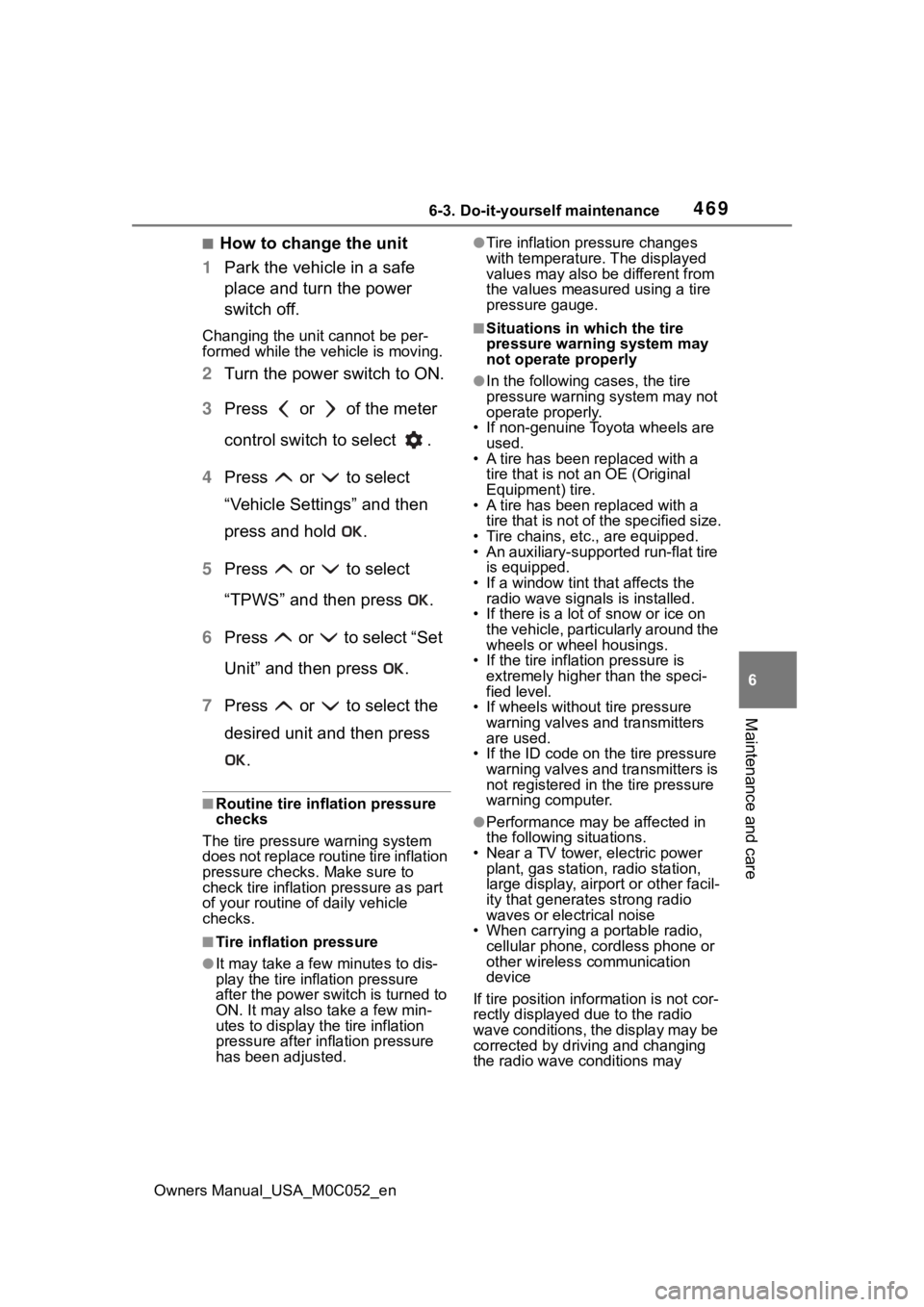
4696-3. Do-it-yourself maintenance
Owners Manual_USA_M0C052_en
6
Maintenance and care
■How to change the unit
1 Park the vehicle in a safe
place and turn the power
switch off.
Changing the unit cannot be per-
formed while the vehicle is moving.
2Turn the power switch to ON.
3 Press or of the meter
control switch to select .
4 Press or to select
“Vehicle Settings” and then
press and hold .
5 Press or to select
“TPWS” and then press .
6 Press or to select “Set
Unit” and then press .
7 Press or to select the
desired unit and then press
.
■Routine tire inflation pressure
checks
The tire pressure warning system
does not replace routine tire inflation
pressure checks. Make sure to
check tire inflation pressure as part
of your routine of daily vehicle
checks.
■Tire inflation pressure
●It may take a few minutes to dis-
play the tire inflation pressure
after the power switch is turned to
ON. It may also take a few min-
utes to display the tire inflation
pressure after inflation pressure
has been adjusted.
●Tire inflation pressure changes
with temperature. The displayed
values may also be different from
the values measured using a tire
pressure gauge.
■Situations in which the tire
pressure warning system may
not operate properly
●In the following cases, the tire
pressure warning system may not
operate properly.
• If non-genuine Toyota wheels are
used.
• A tire has been replaced with a
tire that is not an OE (Original
Equipment) tire.
• A tire has been replaced with a
tire that is not of the specified size.
• Tire chains, etc. , are equipped.
• An auxiliary-support ed run-flat tire
is equipped.
• If a window tint that affects the radio wave signals is installed.
• If there is a lot of snow or ice on
the vehicle, particularly around the
wheels or wheel housings.
• If the tire inflation pressure is
extremely higher than the speci-
fied level.
• If wheels without tire pressure
warning valves and transmitters
are used.
• If the ID code on the tire pressure
warning valves and transmitters is
not registered in the tire pressure
warning computer.
●Performance may be affected in
the following situations.
• Near a TV tower, electric power plant, gas station, radio station,
large display, airpo rt or other facil-
ity that generates strong radio
waves or electrical noise
• When carrying a portable radio,
cellular phone, cordless phone or
other wireless communication
device
If tire position info rmation is not cor-
rectly displayed due to the radio
wave conditions, the display may be
corrected by driving and changing
the radio wave c onditions may
Page 488 of 618
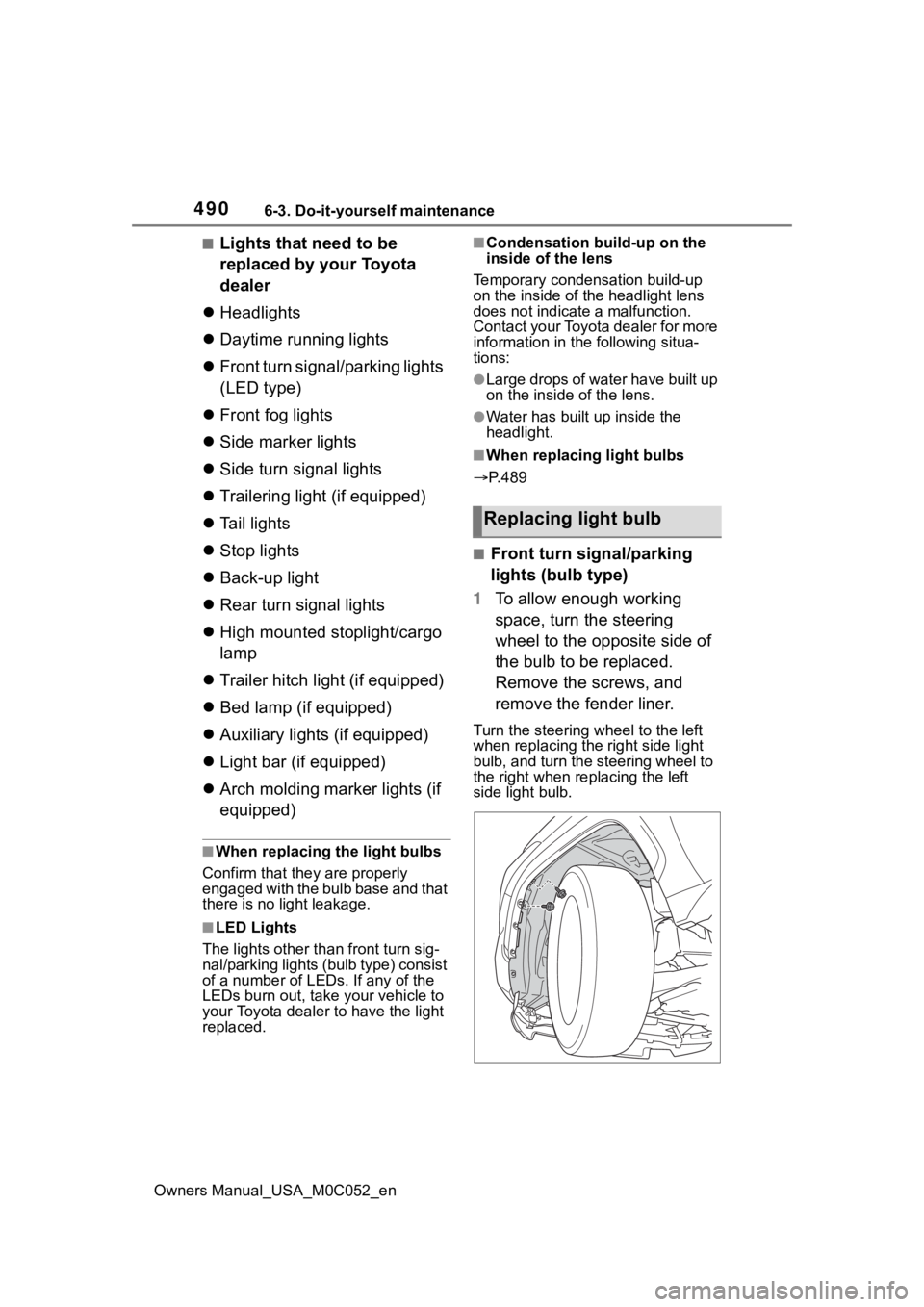
4906-3. Do-it-yourself maintenance
Owners Manual_USA_M0C052_en
■Lights that need to be
replaced by your Toyota
dealer
Headlights
Daytime running lights
Front turn signal/parking lights
(LED type)
Front fog lights
Side marker lights
Side turn signal lights
Trailering light (if equipped)
Tail lights
Stop lights
Back-up light
Rear turn signal lights
High mounted stoplight/cargo
lamp
Trailer hitch light (if equipped)
Bed lamp (if equipped)
Auxiliary lights (if equipped)
Light bar (if equipped)
Arch molding marker lights (if
equipped)
■When replacing the light bulbs
Confirm that they are properly
engaged with the bulb base and that
there is no light leakage.
■LED Lights
The lights other th an front turn sig-
nal/parking lights (bulb type) consist
of a number of LEDs. If any of the
LEDs burn out, take your vehicle to
your Toyota dealer to have the light
replaced.
■Condensation build-up on the
inside of the lens
Temporary condensation build-up
on the inside of t he headlight lens
does not indicate a malfunction.
Contact your Toyota dealer for more
information in t he following situa-
tions:
●Large drops of water have built up
on the inside of the lens.
●Water has built up inside the
headlight.
■When replacing light bulbs
P.489
■Front turn signal/parking
lights (bulb type)
1 To allow enough working
space, turn the steering
wheel to the opposite side of
the bulb to be replaced.
Remove the screws, and
remove the fender liner.
Turn the steering wheel to the left
when replacing the right side light
bulb, and turn the steering wheel to
the right when replacing the left
side light bulb.
Replacing light bulb
Page 575 of 618
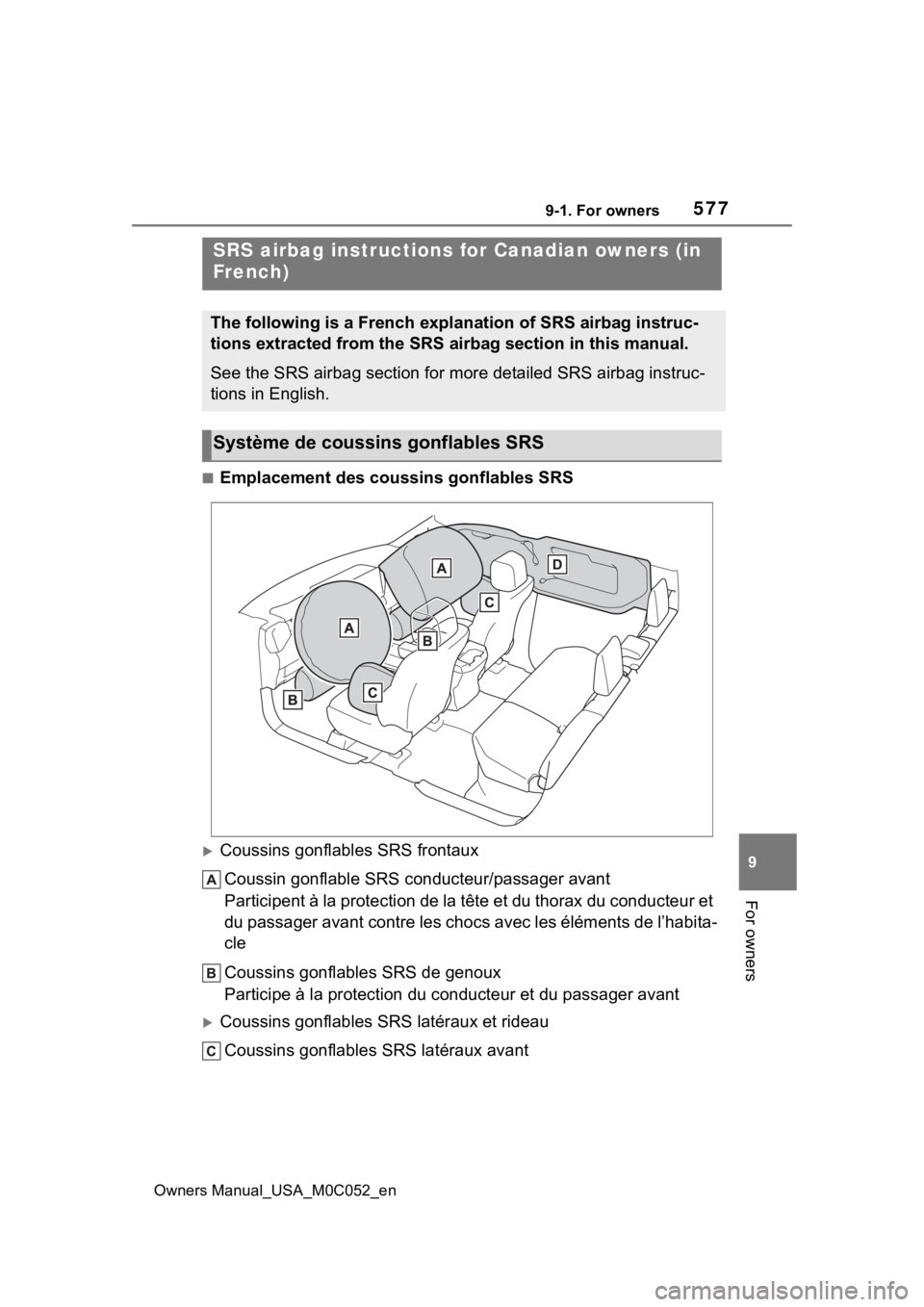
5779-1. For owners
Owners Manual_USA_M0C052_en
9
For owners
■Emplacement des coussins gonflables SRS
Coussins gonflables SRS frontaux Coussin gonflable SRS conducteur/passager avant
Participent à la protection de la tête et du thorax du conducte ur et
du passager avant contre les choc s avec les éléments de l’habita-
cle
Coussins gonflables SRS de genoux
Participe à la protection du conducteur et du passager avant
Coussins gonflables SRS latéraux et rideau
Coussins gonflables SRS latéraux avant
SRS airbag instructions for Canadian owners (in
French)
The following is a French explanation of SRS airbag instruc-
tions extracted from the SRS airbag section in this manual.
See the SRS airbag section for more detailed SRS airbag instruc -
tions in English.
Système de coussins gonflables SRS
Page 576 of 618
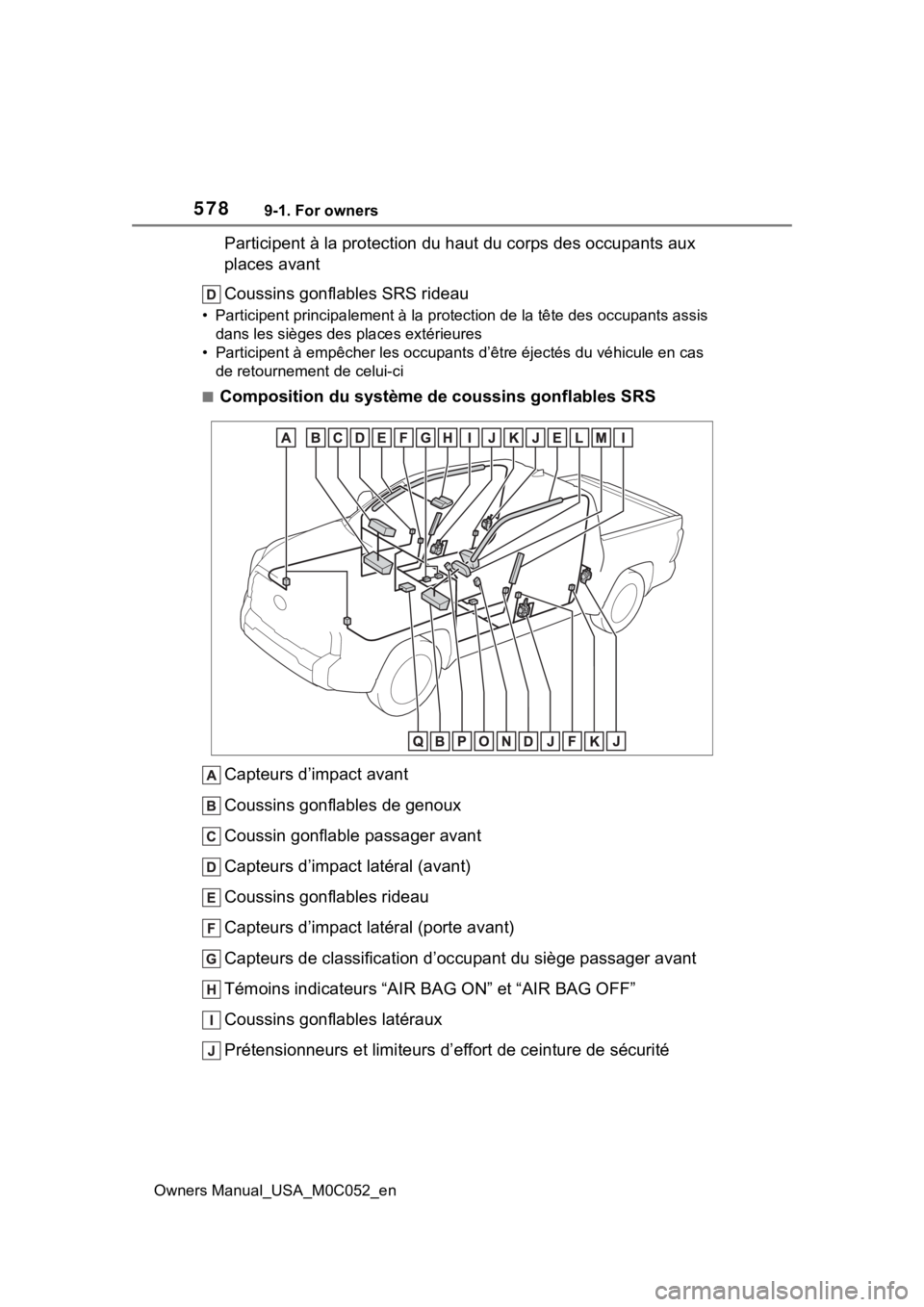
5789-1. For owners
Owners Manual_USA_M0C052_en
Participent à la protection du haut du corps des occupants aux
places avant
Coussins gonflables SRS rideau
• Participent principalement à la protection de la tête des occupants assis
dans les sièges des places extérieures
• Participent à empêcher les occu pants d’être éjectés du véhicule en cas
de retournement de celui-ci
■Composition du système de coussins gonflables SRS
Capteurs d’impact avant
Coussins gonflables de genoux
Coussin gonflable passager avant
Capteurs d’impact latéral (avant)
Coussins gonflables rideau
Capteurs d’impact latéral (porte avant)
Capteurs de classification d’oc cupant du siège passager avant
Témoins indicateurs “AIR BAG ON” et “AIR BAG OFF”
Coussins gonflables latéraux
Prétensionneurs et limiteurs d’effort de ceinture de sécurité
Page 577 of 618
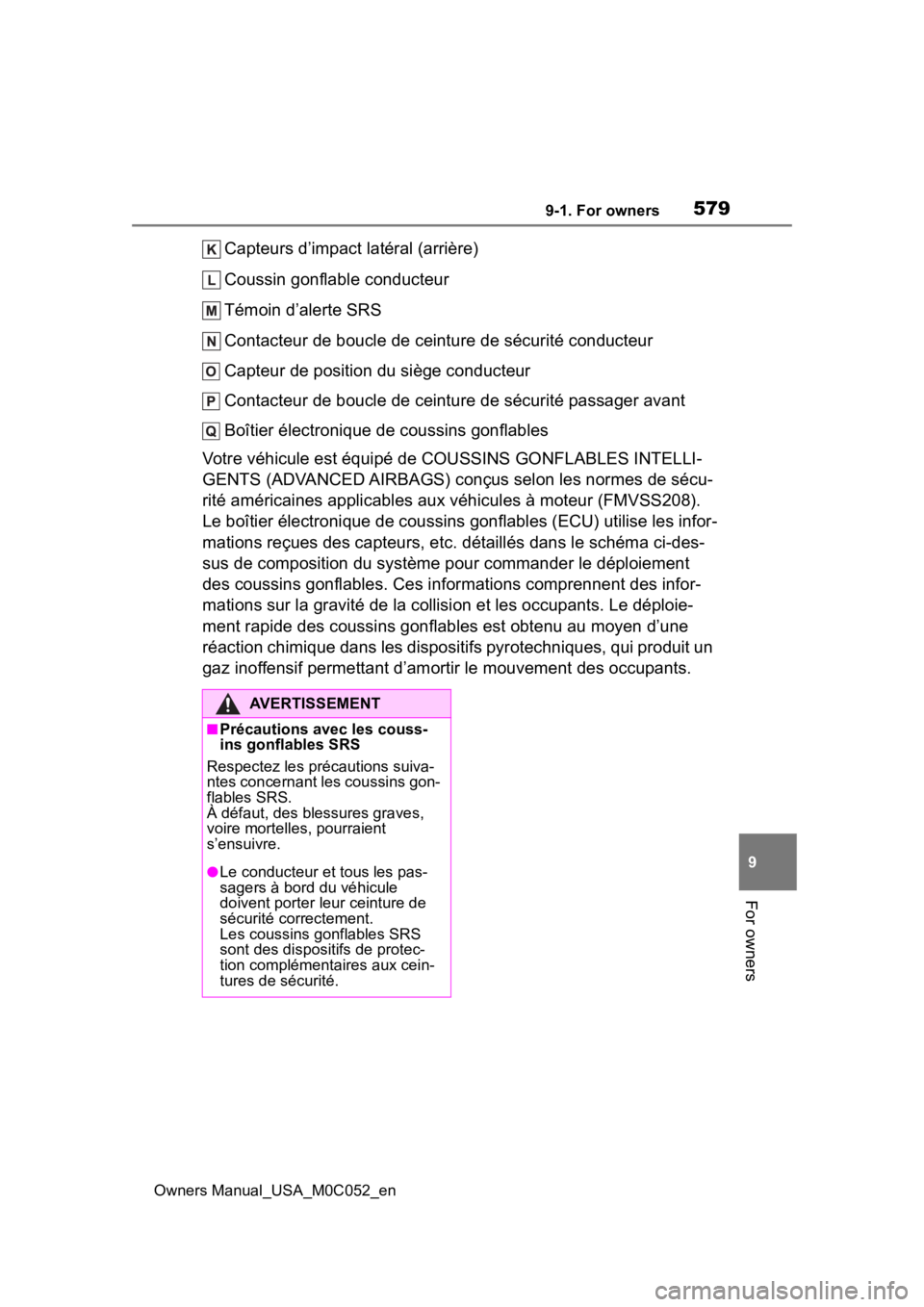
5799-1. For owners
Owners Manual_USA_M0C052_en
9
For owners
Capteurs d’impact latéral (arrière)
Coussin gonflable conducteur
Témoin d’alerte SRS
Contacteur de boucle de ceinture de sécurité conducteur
Capteur de position du siège conducteur
Contacteur de boucle de ceinture de sécurité passager avant
Boîtier électronique de coussins gonflables
Votre véhicule est équipé de COUSSINS GONFLABLES INTELLI-
GENTS (ADVANCED AIRBAGS) conçus selon les normes de sécu-
rité américaines applicables aux véhicules à moteur (FMVSS208).
Le boîtier électronique de coussins gonflables (ECU) utilise le s infor-
mations reçues des capteurs, etc. détaillés dans le schéma ci-d es-
sus de composition du système pour commander le déploiement
des coussins gonflables. Ces inf ormations comprennent des infor-
mations sur la gravité de la collision et les occupants. Le déploie-
ment rapide des coussins gonflables est obtenu au moyen d’une
réaction chimique dans les dispositifs pyrotechniques, qui produit un
gaz inoffensif permettant d’amortir le mouvement des occupants.
AVERTISSEMENT
■Précautions avec les couss-
ins gonflables SRS
Respectez les précautions suiva-
ntes concernant les coussins gon-
flables SRS.
À défaut, des blessures graves,
voire mortelles, pourraient
s’ensuivre.
●Le conducteur et tous les pas-
sagers à bord du véhicule
doivent porter leur ceinture de
sécurité correctement.
Les coussins gonflables SRS
sont des disposit ifs de protec-
tion complémentaires aux cein-
tures de sécurité.